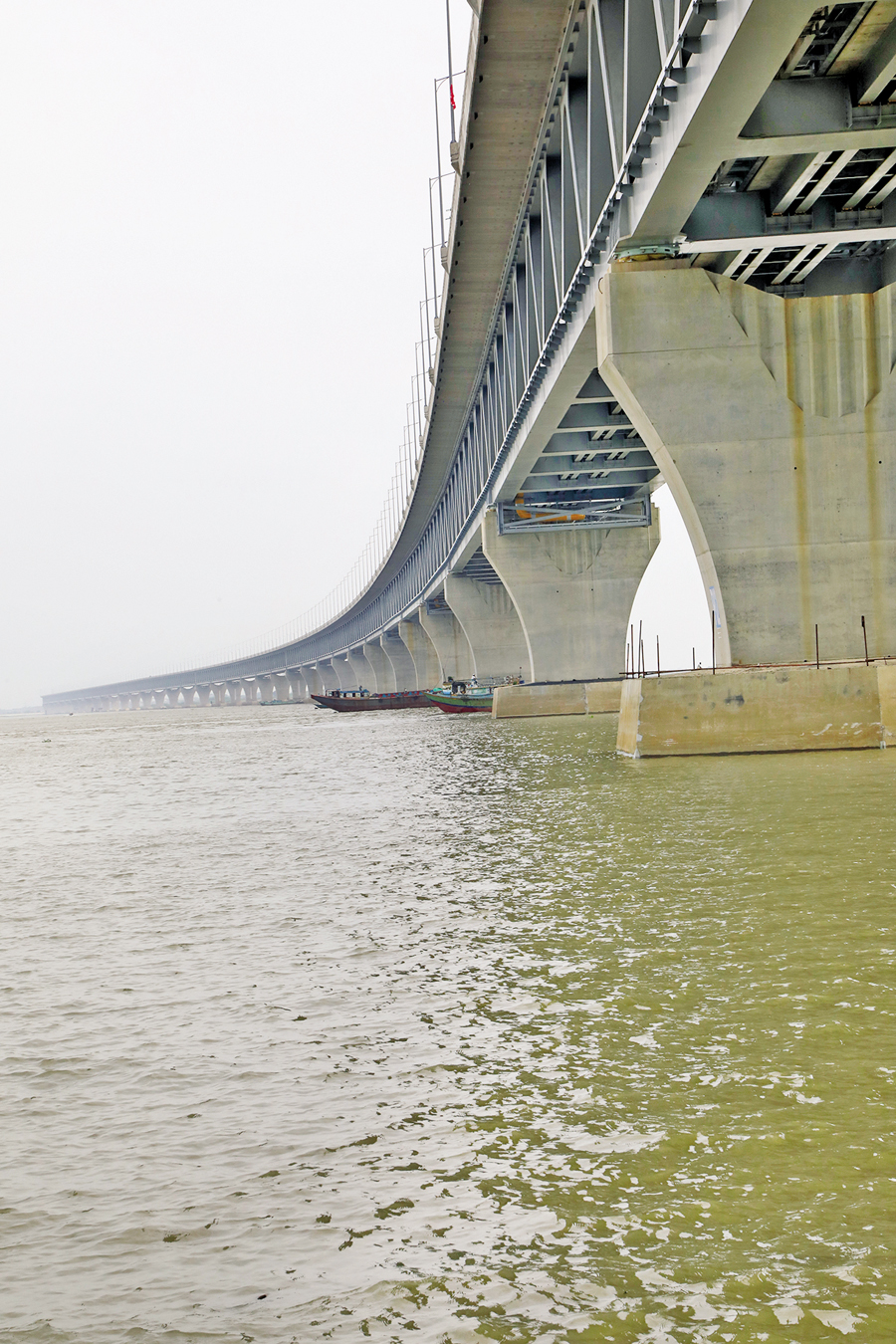
One year of Padma Bridge inauguration
Better connectivity transforming the south
MUNIMA SULTANA | Sunday, 25 June 2023
A year since the momentous opening of Bangladesh’s first self-financed mega Padma Bridge, the nation has witnessed an impressive surge in traffic, surpassing initial expectations.
According to the Bangladesh Bridge Authority (BBA), the executing agency behind the $3.0 billion Padma Multipurpose Bridge project, traffic volume in the past year has tripled compared to the estimates determined during the feasibility study.

This remarkable influx of traffic is a testament to the bridge’s transformative impact on connectivity and accessibility, said economists.
The inauguration of the Padma Bridge by Prime Minister Sheikh Hasina on June 25 marked the dawning of a new era for the southwestern region. Spanning an impressive 6.15 kilometres, the bridge incorporates a road on the upper deck and a rail line on the lower deck, meticulously constructed with a robust steel-truss composite.
These exceptional engineering features signify a significant milestone in Bangladesh’s infrastructure development.
Experts from Dhaka University, including economics professors Selim Raihan and Bazlul Haque Khondker, conducted a study prior to the bridge’s construction.
Their findings projected substantial long-term benefits, with road users alone expected to accumulate a staggering Tk 1.29 trillion (1,295,840 million) in advantages over a span of 31 years.
This infrastructure project stands poised to contribute 1.2 per cent to the country’s gross domestic product (GDP), further solidifying its significance.
Bridges Division Secretary Mohammad Monjur Hossain said that as the bridge project is still within the defect liability period – a period during which the contractor is legally required to rectify defects or complete unfinished work, no initiative has been taken to carry out an impact analysis.
The secretary, who is also the executive director of the Bangladesh Bridge Authority, said the bridge has indeed generated enthusiasm among the people residing on both sides of the river, benefiting trade and businesses.
He mentioned the encouraging increase in traffic volume has facilitated the repayment of the Tk 313.10 billion project loan from the outset. The Road Transport and Bridges Ministry has already presented two checks totalling Tk 6.32 billion to the Prime Minister in two instalments.
In 2012, when the foreign financiers of the project withdrew their support after raising corruption allegations, the Prime Minister demonstrated the courage to continue the expensive project using government funds. The Bridge Authority received the funds as a loan with a 1 per cent interest rate, repayable in 60 instalments with four instalments per year.
The project faced numerous challenges during its construction, particularly due to its location in the delta region. The cost has increased from Tk 230 billion to Tk 313.10 billion after four revisions since 2012.
The main bridge construction and river training works under the project were contracted to two Chinese companies – China Major Bridge and Sinohydro Corporation.
Although the inauguration of the Padma Bridge has yet to attract significant investments in the southwestern region, a noticeable shift in land use has been observed with the development of small-scale farming, hotel restaurants, resorts and other ventures.
Many residents of Dhaka have also relocated to the other side of the river due to significantly reduced travel time. Residents of Barishal, Magura and nearby districts have reported reaching their homes within three hours, whereas the travel time was previously around a day.
Dhaka University economics Professor Selim Raihan believes that due to the absence of a Padma Plus policy, the expected investment in the areas surrounding the bridge has not been fully visible in the past 12 months.
He noted that analysing the impact of the infrastructure on GDP cannot solely rely on traffic movement as it accounts for only a quarter of the assessment.
The Bangladesh Bridge Authority, responsible for constructing the Bangabandhu Jamuna Bridge, collected Tk 5.0 billion in tolls from the country’s second-largest bridge between July and March. During the same period, toll collection from the Padma Bridge amounted to Tk 6.03 billion.
The highest toll collection of Tk 41.9 million occurred on a single day ahead of the Eid-ul-Azha holidays. While the road cum rail bridge typically experiences 13,300 vehicles per day, it received over 31,000 vehicles on that specific day.
Monjurul Alam Mizan, head of operations at local realtor Imperial Real Estate, said the demand for real estate in the southwestern districts has increased due to the bridge, as many people prefer daily travel rather than staying in the capital for work.
Imperial has already opened a regional office in Magura and commenced five projects in the area.
While speaking on condition of anonymity, an official from a private tiles factory located in Bhola district described the indirect impact on the economy following the Padma Bridge opening, as they now have access to improved ferry services due to the relocation of ferries from the bridge’s location.
Previously, they faced long wait times for riverine transportation of goods.
Selim Raihan, who also serves as the executive director at the South Asian Network on Economic Modeling (SANEM), commented that traffic, which is one of the three sources for economic impact analysis, cannot work alone to drive industrialisation and service development in economically disadvantaged parts of the country.
He told the FE that ushering economic activities requires additional support and the implementation of a Padma Plus policy by the government, which could have initiated changes by ensuring the availability of gas, electricity and banking products.
The FE talked to some officials at the central bank and other commercial banks and found they are yet to take any specific plan focusing on boosting economic activities on the southern side of the Padma bridge.
The bankers said neither they received any proposal from any investors nor they are interested in financing due to a lack of government-side interventions.
smunima@yahoo.com